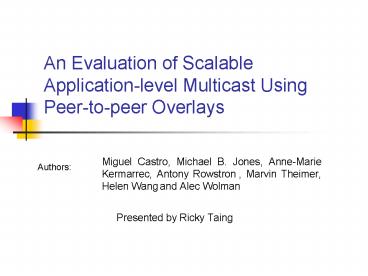An Evaluation of Scalable Applicationlevel Multicast Using Peertopeer Overlays PowerPoint PPT Presentation
Title: An Evaluation of Scalable Applicationlevel Multicast Using Peertopeer Overlays
1
An Evaluation of Scalable Application-level
Multicast Using Peer-to-peer Overlays
- Miguel Castro, Michael B. Jones, Anne-Marie
Kermarrec, Antony Rowstron , Marvin Theimer,
Helen Wang and Alec Wolman - Presented by Ricky Taing
Authors
2
Outline
- Motivations and Goals of Paper
- Overview of Overlay Networks
- Overview of p2p Multicast Implementations
- Experimental Methodology
- Results
- Conclusions
3
Motivations and Goals
- Lack of IP multicast adoption has increased
development in app-layer multicast - Different versions available to use, with
different implementations - Determine the best application layer multicast
system from different overlays and implementations
4
P2P Overlay Networks
- Two main approaches
- Divide and conquer in a ring
- Pastry, Chord, Tapestry
- Cartesian hyper-space
- CAN
5
Pastry
- Routes by nodeID
- Circular 128-bit namespace
- Get to destination in log 2b N time
- b is configurable, usually b4 (hex)
- Each node maintains a leaf set
- pointers to l nodes closest to it
6
CAN
- Route in multiple dimensions
- Each node is assigned a particular zone
- Many optimizations
- Neighbor with lowest network delay
- Multiple nodes per zone
- Uniform partitioning
- Landmark based placement
7
Landmark based placement
- Set of well known landmarks
- ordered by distance
- placed into evenly sized bins
- Nodes with same landmark ordering end up close to
each other
8
P2P Multicast Implementations
- Flooding
- Unique overlay-per-group
- Only nodes in group get group messages
- CAN
- broadcast to neighbors, use seq numbers
- Pastry
- Forwards copies to all nodes in routing table
- Notes levels, sends to greater levels
9
Tree-based
- Scribe
- Reverse path forwarding to create one tree per
group - Joins route messages to groupId (root)
- Registers if a node along the route is in the tree
10
Evaluation
- Simulation
- Five different topologies
- 5050 routers, 80000 end nodes
- Two sets of experiments
- Single multicast group, all nodes are members
- Large number of groups (1500)
11
Criteria
- Relative Delay Penalty
- RMD Ratio of Maximum delay between app and IP
multicast - RAD Ratio of Average delay between app and IP
Multicast - Link Stress
- number of packets sent over link
12
Criteria (2)
- Node Stress
- Number of nodes in a routing table
- Number of messages received by a join
- Duplicates
- Number received by end nodes
13
CANFlooding Results
- Landmark based and NDR (lowest network delay) was
best - Benefits from increased table state is uneven
- Link stress for 80,000 joins is huge
- Increases with state size
- Link stress is significantly lower for sent
messages
14
Link stress CANFlooding
15
CANTree Results
- Landmark based assignment of nodes better
- Delay is better than flooding by a factor of 2 to
3 - Link stress for joins and sends are relatively
similar
16
Pastry Tart and Tangy
- varied b from 1 to 4
- TART
- Topology aware routing table construction
- default optimization
- nodes probe each other to estimate delay
- TOP
- Topology aware nodeId assignment
- currently random / distributed
17
PastryFlooding Results
- delay decreases as b increases
- delay of b4 is 50 lower than b1
- TART and TOP both decrease delay
- TOP reduces average link stress by factor of 3
and max link stress by a factor of 30 - Large number of duplicates when b is large (16
b4) - due to holes in routing tables
18
PastryTree Results
- delay decreases as b increases, and with TART and
TOP - similar to flooding results
- TART reduces both max and avg link stress
- TOP reduces avg but increases max link stress
- Pastry with TART and without TOP is best for
tree-based
19
Multiple multicast
- Tree based Pastry was best for delay
- Interesting is CAN Flooding average CDF curve
not tightly bound - Flooding is better in the 1500 group experiment
than the single group
20
Max Delay Penalties
21
Average Delay Penalties
22
Evaluation
- For delay, Pastry is 20-50 better than CAN
- For average link stress, Pastry was 15 lower
- Max link stress CAN was 25 lower
23
Conclusion
- Separate overlays are only better if you want to
limit nodes that route traffic - More overhead for flooding approach
- Tree base can reuse the same overlay for multiple
groups - Less delay, joins and sends are more lightweight
- Multicast trees with Pastry have better
performance than CAN

